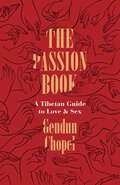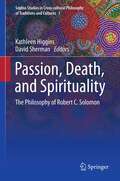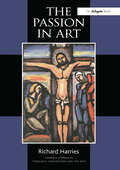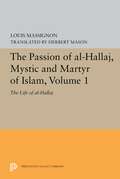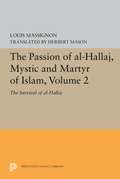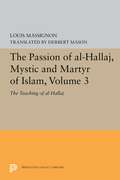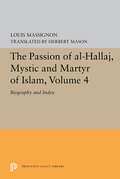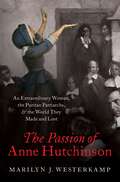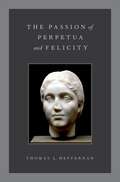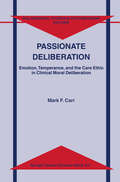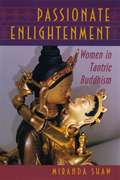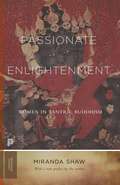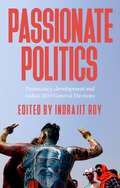- Table View
- List View
The Passion Book: A Tibetan Guide to Love and Sex (Buddhism and Modernity)
by Gendun ChopelThe PassionBook is the most famous work of erotica in the vast literature of Tibetan Buddhism, written by the legendary scholar and poet Gendun Chopel (1903-1951). Soon after arriving in India in 1934, he discovered the Kama Sutra. Realizing that this genre of the erotic was unknown in Tibet, he set out to correct the situation. His sources were two: classical Sanskrit works and his own experiences with his lovers. Completed in 1939, his “treatise on passion” circulated in manuscript form in Tibet, scandalizing and arousing its readers. Gendun Chopel here condemns the hypocrisy of both society and church, portraying sexual pleasure as a force of nature and a human right for all. On page after page, we find the exuberance of someone discovering the joys of sex, made all the more intense because they had been forbidden to him for so long: he had taken the monastic vow of celibacy in his youth and had only recently renounced it. He describes in ecstatic and graphic detail the wonders he discovered. In these poems, written in beautiful Tibetan verse, we hear a voice with tints of irony, self-deprecating wit, and a love of women not merely as sources of male pleasure but as full partners in the play of passion.
The Passion Book: A Tibetan Guide to Love and Sex (Buddhism and Modernity)
by Gendun ChopelThe PassionBook is the most famous work of erotica in the vast literature of Tibetan Buddhism, written by the legendary scholar and poet Gendun Chopel (1903-1951). Soon after arriving in India in 1934, he discovered the Kama Sutra. Realizing that this genre of the erotic was unknown in Tibet, he set out to correct the situation. His sources were two: classical Sanskrit works and his own experiences with his lovers. Completed in 1939, his “treatise on passion” circulated in manuscript form in Tibet, scandalizing and arousing its readers. Gendun Chopel here condemns the hypocrisy of both society and church, portraying sexual pleasure as a force of nature and a human right for all. On page after page, we find the exuberance of someone discovering the joys of sex, made all the more intense because they had been forbidden to him for so long: he had taken the monastic vow of celibacy in his youth and had only recently renounced it. He describes in ecstatic and graphic detail the wonders he discovered. In these poems, written in beautiful Tibetan verse, we hear a voice with tints of irony, self-deprecating wit, and a love of women not merely as sources of male pleasure but as full partners in the play of passion.
The Passion Book: A Tibetan Guide to Love and Sex (Buddhism and Modernity)
by Gendun ChopelThe PassionBook is the most famous work of erotica in the vast literature of Tibetan Buddhism, written by the legendary scholar and poet Gendun Chopel (1903-1951). Soon after arriving in India in 1934, he discovered the Kama Sutra. Realizing that this genre of the erotic was unknown in Tibet, he set out to correct the situation. His sources were two: classical Sanskrit works and his own experiences with his lovers. Completed in 1939, his “treatise on passion” circulated in manuscript form in Tibet, scandalizing and arousing its readers. Gendun Chopel here condemns the hypocrisy of both society and church, portraying sexual pleasure as a force of nature and a human right for all. On page after page, we find the exuberance of someone discovering the joys of sex, made all the more intense because they had been forbidden to him for so long: he had taken the monastic vow of celibacy in his youth and had only recently renounced it. He describes in ecstatic and graphic detail the wonders he discovered. In these poems, written in beautiful Tibetan verse, we hear a voice with tints of irony, self-deprecating wit, and a love of women not merely as sources of male pleasure but as full partners in the play of passion.
The Passion Book: A Tibetan Guide to Love and Sex (Buddhism and Modernity)
by Gendun ChopelThe PassionBook is the most famous work of erotica in the vast literature of Tibetan Buddhism, written by the legendary scholar and poet Gendun Chopel (1903-1951). Soon after arriving in India in 1934, he discovered the Kama Sutra. Realizing that this genre of the erotic was unknown in Tibet, he set out to correct the situation. His sources were two: classical Sanskrit works and his own experiences with his lovers. Completed in 1939, his “treatise on passion” circulated in manuscript form in Tibet, scandalizing and arousing its readers. Gendun Chopel here condemns the hypocrisy of both society and church, portraying sexual pleasure as a force of nature and a human right for all. On page after page, we find the exuberance of someone discovering the joys of sex, made all the more intense because they had been forbidden to him for so long: he had taken the monastic vow of celibacy in his youth and had only recently renounced it. He describes in ecstatic and graphic detail the wonders he discovered. In these poems, written in beautiful Tibetan verse, we hear a voice with tints of irony, self-deprecating wit, and a love of women not merely as sources of male pleasure but as full partners in the play of passion.
The Passion Book: A Tibetan Guide to Love and Sex (Buddhism and Modernity)
by Gendun ChopelThe PassionBook is the most famous work of erotica in the vast literature of Tibetan Buddhism, written by the legendary scholar and poet Gendun Chopel (1903-1951). Soon after arriving in India in 1934, he discovered the Kama Sutra. Realizing that this genre of the erotic was unknown in Tibet, he set out to correct the situation. His sources were two: classical Sanskrit works and his own experiences with his lovers. Completed in 1939, his “treatise on passion” circulated in manuscript form in Tibet, scandalizing and arousing its readers. Gendun Chopel here condemns the hypocrisy of both society and church, portraying sexual pleasure as a force of nature and a human right for all. On page after page, we find the exuberance of someone discovering the joys of sex, made all the more intense because they had been forbidden to him for so long: he had taken the monastic vow of celibacy in his youth and had only recently renounced it. He describes in ecstatic and graphic detail the wonders he discovered. In these poems, written in beautiful Tibetan verse, we hear a voice with tints of irony, self-deprecating wit, and a love of women not merely as sources of male pleasure but as full partners in the play of passion.
Passion, Death, and Spirituality: The Philosophy of Robert C. Solomon (Sophia Studies in Cross-cultural Philosophy of Traditions and Cultures #1)
by Kathleen Higgins and David ShermanRobert C. Solomon, who died in 2007, was Professor of Philosophy and Quincy Lee Centennial Professor of Business at the University of Texas, USA. As the first book comprehensively to examine the breadth of Solomon’s contribution to philosophy, this volume ranks as a vital addition to the literature. It includes a newly published transcript of Solomon’s last talk, which responded to Arindam Chakrabarti on the concept of revenge, as well as the considered views of prominent figures in the numerous subfields in which Solomon worked. The content analyses his perspectives on the philosophy of emotion, virtue, business ethics, and religion, in addition to philosophical history, existentialism, and the many other topics that held this prolific thinker’s attention. Solomon memorably defined philosophy itself as ‘the thoughtful love of life’, and despite the diversity of his output, he was most drawn by central questions about the meaning of life, the essential role that emotions play in finding that meaning, and the human imperative to seek ‘emotional integrity’, in which one’s thoughts, emotions, and actions all contribute to a coherent narrative. The essays included here draw attention to the interconnections between the issues Solomon addressed, and evince the manner in which he embodied that integrity, living a life at one with his philosophy. They emphasize the central themes of passion, ethics, and spirituality, which threaded through his work, and the way these ideas informed his views on how we should approach grief and death. The multiplicity of topics alone make this keystone work an enlightening read for a full spectrum of students of philosophy, providing much to ponder and recounting a subtle and shining example of the emotional integrity Solomon worked so hard to define.
The Passion in Art (Routledge Studies in Theology, Imagination and the Arts)
by Richard HarriesJesus was not depicted on the cross until the early fifth century. Since then this scene has been painted or carved in sharply differing ways. With the aid of over thirty full-page plates, The Passion in Art explores the historical contexts and theologies that led to such differing depictions. Because the first Christians saw the Crucifixion and Resurrection of Jesus as different aspects of a unified victory over sin and death, scenes of the Passion are juxtaposed with some of the Resurrection, which again are highly varied in what they do and do not show. This is the first book to consider the Passion as portrayed in the whole sweep of Christian history. Each picture is considered both from the point of view of its context and its theological standpoint. Spanning the centuries, the images reproduced and discussed include: scenes from the Passion of Christ in the Catacombs of Domitilla, mosaics in Ravenna, the Rabbula Crucifixion and Resurrection, the Crucifixion Plaque from Metz, the Gero Crucifix, Cimabue's Crucifix, Giotto's Noli me Tangere, Piero della Francesca's Resurrection, the Isenheim altarpiece, Caravaggio's Supper at Emmaus, Rembrandt's Christ on the Cross, Chagall's White Crucifixion, contemporary paintings by Stanley Spencer, Graham Sutherland, Nicholas Mynheer, and many more works of great acclaim.
The Passion in Art (Routledge Studies in Theology, Imagination and the Arts)
by Richard HarriesJesus was not depicted on the cross until the early fifth century. Since then this scene has been painted or carved in sharply differing ways. With the aid of over thirty full-page plates, The Passion in Art explores the historical contexts and theologies that led to such differing depictions. Because the first Christians saw the Crucifixion and Resurrection of Jesus as different aspects of a unified victory over sin and death, scenes of the Passion are juxtaposed with some of the Resurrection, which again are highly varied in what they do and do not show. This is the first book to consider the Passion as portrayed in the whole sweep of Christian history. Each picture is considered both from the point of view of its context and its theological standpoint. Spanning the centuries, the images reproduced and discussed include: scenes from the Passion of Christ in the Catacombs of Domitilla, mosaics in Ravenna, the Rabbula Crucifixion and Resurrection, the Crucifixion Plaque from Metz, the Gero Crucifix, Cimabue's Crucifix, Giotto's Noli me Tangere, Piero della Francesca's Resurrection, the Isenheim altarpiece, Caravaggio's Supper at Emmaus, Rembrandt's Christ on the Cross, Chagall's White Crucifixion, contemporary paintings by Stanley Spencer, Graham Sutherland, Nicholas Mynheer, and many more works of great acclaim.
The Passion of Al-Hallaj, Mystic and Martyr of Islam, Volume 1: The Life of Al-Hallaj (Princeton Legacy Library #5591)
by Louis MassignonVolume 1 of 4. Encompassing the whole milieu of early Islamic civilization, this major work of Western orientalism explores the meaning of the life and teaching of the tenth-century mystic and martyr, al-Hallaj. With profound spiritual insight and transcultural sympathy, Massignon, an Islamicist and scholar of religion, penetrates Islamic mysticism in a way that was previously unknown.Massignon traveled throughout the Middle East and western India to gather and authenticate al-Hallaj's surviving writings and the recorded facts. After assembling the extant verses and prose works of al-Hallaj and the accounts of his life and death, Massignon published La Passion d'al-Hallaj in 1922. At his death in 1962, he left behind a greatly expanded version, published as the second French edition (1975). It is edited and translated here from the French and the Arabic sources by Massignon's friend and pupil, Herbert Mason.Volume 1 gives an account of al-Hallaj's life and describes the wo rld in which he lives; volume 2 traces his influence in Islam over the centuries; volume 3 studies Hallajian thought; volume 4 contains a full biography and index. Each volume contains Massignon's copious notes and new translations of original Islamic documents.Herbert Mason is University Professor of Religion and Islamic History at Boston University. He is also apoet and novelist; his version of the Gigamesh epic was a nominee for the National Book Award in 1971.Bollingen Sreis XCVIII.Originally published in 1986.The Princeton Legacy Library uses the latest print-on-demand technology to again make available previously out-of-print books from the distinguished backlist of Princeton University Press. These editions preserve the original texts of these important books while presenting them in durable paperback and hardcover editions. The goal of the Princeton Legacy Library is to vastly increase access to the rich scholarly heritage found in the thousands of books published by Princeton University Press since its founding in 1905.
The Passion of Al-Hallaj, Mystic and Martyr of Islam, Volume 2: The Survival of al-Hallaj (Princeton Legacy Library #5615)
by Louis MassignonVolume 2 of 4. Encompassing the whole milieu of early Islamic civilization, this major work of Western orientalism explores the meaning of the life and teaching of the tenth-century mystic and martyr, al-Hallaj. With profound spiritual insight and transcultural sympathy, Massignon, an Islamicist and scholar of religion, penetrates Islamic mysticism in a way that was previously unknown.Massignon traveled throughout the Middle East and western India to gather and authenticate al-Hallaj's surviving writings and the recorded facts. After assembling the extant verses and prose works of al-Hallaj and the accounts of his life and death, Massignon published La Passion d'al-Hallaj in 1922. At his death in 1962, he left behind a greatly expanded version, published as the second French edition (1975). It is edited and translated here from the French and the Arabic sources by Massignon's friend and pupil, Herbert Mason.Volume 1 gives an account of al-Hallaj's life and describes the wo rld in which he lives; volume 2 traces his influence in Islam over the centuries; volume 3 studies Hallajian thought; volume 4 contains a full biography and index. Each volume contains Massignon's copious notes and new translations of original Islamic documents.Herbert Mason is University Professor of Religion and Islamic History at Boston University. He is also apoet and novelist; his version of the Gigamesh epic was a nominee for the National Book Award in 1971.Bollingen Series XCVIII.Originally published in 1972.The Princeton Legacy Library uses the latest print-on-demand technology to again make available previously out-of-print books from the distinguished backlist of Princeton University Press. These editions preserve the original texts of these important books while presenting them in durable paperback and hardcover editions. The goal of the Princeton Legacy Library is to vastly increase access to the rich scholarly heritage found in the thousands of books published by Princeton University Press since its founding in 1905.
The Passion of Al-Hallaj, Mystic and Martyr of Islam, Volume 3: The Teaching of al-Hallaj (Princeton Legacy Library #5618)
by Louis MassignonVolume 3 of 4. Encompassing the whole milieu of early Islamic civilization, this major work of Western orientalism explores the meaning of the life and teaching of the tenth-century mystic and martyr, al-Hallaj. With profound spiritual insight and transcultural sympathy, Massignon, an Islamicist and scholar of religion, penetrates Islamic mysticism in a way that was previously unknown.Massignon traveled throughout the Middle East and western India to gather and authenticate al-Hallaj's surviving writings and the recorded facts. After assembling the extant verses and prose works of al-Hallaj and the accounts of his life and death, Massignon published La Passion d'al-Hallaj in 1922. At his death in 1962, he left behind a greatly expanded version, published as the second French edition (1975). It is edited and translated here from the French and the Arabic sources by Massignon's friend and pupil, Herbert Mason.Volume 1 gives an account of al-Hallaj's life and describes the wo rld in which he lives; volume 2 traces his influence in Islam over the centuries; volume 3 studies Hallajian thought; volume 4 contains a full biography and index. Each volume contains Massignon's copious notes and new translations of original Islamic documents.Herbert Mason is University Professor of Religion and Islamic History at Boston University. He is also apoet and novelist; his version of the Gigamesh epic was a nominee for the National Book Award in 1971.Bollingen Series XCVIII.Originally published in 1972.The Princeton Legacy Library uses the latest print-on-demand technology to again make available previously out-of-print books from the distinguished backlist of Princeton University Press. These editions preserve the original texts of these important books while presenting them in durable paperback and hardcover editions. The goal of the Princeton Legacy Library is to vastly increase access to the rich scholarly heritage found in the thousands of books published by Princeton University Press since its founding in 1905.
The Passion of Al-Hallaj, Mystic and Martyr of Islam, Volume 4: Biography and Index (Princeton Legacy Library #5620)
by Louis MassignonVolume 4 of 4. Encompassing the whole milieu of early Islamic civilization, this major work of Western orientalism explores the meaning of the life and teaching of the tenth-century mystic and martyr, al-Hallaj. With profound spiritual insight and transcultural sympathy, Massignon, an Islamicist and scholar of religion, penetrates Islamic mysticism in a way that was previously unknown.Massignon traveled throughout the Middle East and western India to gather and authenticate al-Hallaj's surviving writings and the recorded facts. After assembling the extant verses and prose works of al-Hallaj and the accounts of his life and death, Massignon published La Passion d'al-Hallaj in 1922. At his death in 1962, he left behind a greatly expanded version, published as the second French edition (1975). It is edited and translated here from the French and the Arabic sources by Massignon's friend and pupil, Herbert Mason.Volume 1 gives an account of al-Hallaj's life and describes the world in which he lives; volume 2 traces his influence in Islam over the centuries; volume 3 studies Hallajian thought; volume 4 contains a full biography and index. Each volume contains Massignon's copious notes and new translations of original Islamic documents.Herbert Mason is University Professor of Religion and Islamic History at Boston University. He is also a poet and novelist; his version of the Gigamesh epic was a nominee for the National Book Award in 1971.Bollingen Series XCVIII.Originally published in 1979.The Princeton Legacy Library uses the latest print-on-demand technology to again make available previously out-of-print books from the distinguished backlist of Princeton University Press. These editions preserve the original texts of these important books while presenting them in durable paperback and hardcover editions. The goal of the Princeton Legacy Library is to vastly increase access to the rich scholarly heritage found in the thousands of books published by Princeton University Press since its founding in 1905.
The Passion of Anne Hutchinson: An Extraordinary Woman, the Puritan Patriarchs, and the World They Made and Lost
by Marilyn J. WesterkampWhen English colonizers landed in New England in 1630, they constructed a godly commonwealth according to precepts gleaned from Scripture. For these 'Puritan' Christians, religion both provided the center and defined the margins of existence. While some Puritans were called to exercise power as magistrates and ministers, and many more as husbands and fathers, women were universally called to subject themselves to the authority of others. Their God was a God of order, and out of their religious convictions and experiences Puritan leaders found a divine mandate for a firm, clear hierarchy. Yet not all lives were overwhelmed; other religious voices made themselves heard, and inspired voices that defied that hierarchy. Gifted with an extraordinary mind, an intense spiritual passion, and an awesome charisma, Anne Hutchinson arrived in Massachusetts in 1634 and established herself as a leader of women. She held private religious meetings in her home and later began to deliver her own sermons. She inspired a large number of disciples who challenged the colony's political, social, and ideological foundations, and scarcely three years after her arrival, Hutchinson was recognized as the primary disrupter of consensus and order--she was then banished as a heretic. Anne Hutchinson, deeply centered in her spirituality, heard in the word of God an imperative to ignore and move beyond the socially prescribed boundaries placed around women. The Passion of Anne Hutchinson examines issues of gender, patriarchal order, and empowerment in Puritan society through the story of a woman who sought to preach, inspire, and disrupt.
The Passion of Anne Hutchinson: An Extraordinary Woman, the Puritan Patriarchs, and the World They Made and Lost
by Marilyn J. WesterkampWhen English colonizers landed in New England in 1630, they constructed a godly commonwealth according to precepts gleaned from Scripture. For these 'Puritan' Christians, religion both provided the center and defined the margins of existence. While some Puritans were called to exercise power as magistrates and ministers, and many more as husbands and fathers, women were universally called to subject themselves to the authority of others. Their God was a God of order, and out of their religious convictions and experiences Puritan leaders found a divine mandate for a firm, clear hierarchy. Yet not all lives were overwhelmed; other religious voices made themselves heard, and inspired voices that defied that hierarchy. Gifted with an extraordinary mind, an intense spiritual passion, and an awesome charisma, Anne Hutchinson arrived in Massachusetts in 1634 and established herself as a leader of women. She held private religious meetings in her home and later began to deliver her own sermons. She inspired a large number of disciples who challenged the colony's political, social, and ideological foundations, and scarcely three years after her arrival, Hutchinson was recognized as the primary disrupter of consensus and order--she was then banished as a heretic. Anne Hutchinson, deeply centered in her spirituality, heard in the word of God an imperative to ignore and move beyond the socially prescribed boundaries placed around women. The Passion of Anne Hutchinson examines issues of gender, patriarchal order, and empowerment in Puritan society through the story of a woman who sought to preach, inspire, and disrupt.
The Passion of Max von Oppenheim: Archaeology and Intrigue in the Middle East from Wilhelm II to Hitler
by Lionel GossmanBorn into a prominent German Jewish banking family, Baron Max von Oppenheim (1860-1946) was a keen amateur archaeologist and ethnologist. His discovery and excavation of Tell Halaf in Syria marked an important contribution to knowledge of the ancient Middle East, while his massive study of the Bedouins is still consulted by scholars today. He was also an ardent German patriot, eager to support his country's pursuit of its "place in the sun". Excluded by his part-Jewish ancestry from the regular diplomatic service, Oppenheim earned a reputation as "the Kaiser's spy" because of his intriguing against the British in Cairo, as well as his plan, at the start of the First World War, to incite Muslims under British, French and Russian rule to a jihad against the colonial powers. After 1933, despite being half-Jewish according to the Nuremberg Laws, Oppenheim was not persecuted by the Nazis. In fact, he placed his knowledge of the Middle East and his connections with Muslim leaders at the service of the regime. Ranging widely over many fields—from war studies to archaeology and banking history—The Passion of Max von Oppenheim tells the gripping and at times unsettling story of one part-Jewish man's passion for his country in the face of persistent and, in his later years, genocidal anti-Semitism.
The Passion of Perpetua and Felicity
by Thomas J. HeffernanWinner of the Modern Language Association Prize for a Scholarly Edition One of the most widely read and studied texts composed in Late Antiquity is the prison diary of Vibia Perpetua, a young woman of the elite classes who was martyred in March of the year 202 or 203 C.E. in Carthage, as part of a civic celebration honoring Caesar Geta. She was well-married and had recently become the mother of a baby son, but despite her advantages, she refused to recant her faith when she was arrested with other recent converts to Christianity. Imprisoned with her was her pregnant slave Felicity. Perpetua's steadfastness in her belief led to her martyrdom in the amphitheater. A description of the heroic deaths of both women, and the autobiography of one of the leaders of the Christian community, Saturus, is woven into Perpetua's diary by an anonymous editor, who tells us that, as they died, Perpetua, Felicity, and the other condemned Christians bid farewell with a kiss of peace. This unique and precious text survives in one Greek and in nine Latin manuscript versions. Thomas Heffernan's new study contains much that has never been done before, including a prosopography of all the individuals mentioned in the Passion, a new English translation and the first detailed historical commentary in English on the entire narrative of the Passion. It also includes a newly edited version of the Latin text based on all the extant manuscripts and - rarer still - the Greek text. He concludes the book with a complete codicological description of all of the known manuscripts and thorough scholarly indices of the text itself. Perpetua's prison diary is a revered text of early Christianity, and Heffernan's new translation and commentary brings unprecedented scholarly resources to the much-loved Passion.
Passionate Deliberation: Emotion, Temperance, and the Care Ethic in Clinical Moral Deliberation (Philosophical Studies in Contemporary Culture #8)
by M.F. CarrDespite the modem recovery of virtue theory in ethics, conceptions of temperance remain largely unexamined. In this study I offer an examination ofcertain interpretive threads oftemperance as a virtue beginning in classical philosophy and moving through early to medieval Christian conceptions. I find contemporary notions oftemperance to be sorely lacking when compared and contrasted to these historical conceptions. Aristotelian and Thomistic accounts of temperance are particularly important to the normative statement of temperance I offer here. To fully understand temperance one must recognize its place among the moral virtues, in particular phronesis or practical judgment. Though I place temperance within practical judgment, this study stops short ofoffering a full account of virtue theory and how it mayor may not relate to other theories ofthe moral life. While contemporary views of temperance occasionally note its general relevance to the experience of emotion, I elaborate upon the work of temperance as an essential part of the effort to include emotion in the moral life. In present-day studies of the psychology of emotion, cognitive theories have reasserted the classical conception of emotion as consisting of both physiological and psychological elements ofhuman personhood. Temperance is the primary virtue in the moral agent's effort to appropriately include the entirety ofthe emotional experience in moral deliberation. I find it relevant to a moral response to both the physiological and psychological elements of emotion.
The Passionate Encounters Collection
by Jules Bennett Sarah M. Anderson Lindsay Armstrong Michelle Reid Michelle Smart Jennie Lucas Caitlin Crews Dani Wade Kim Lawrence Amanda Cinelli Abby Blake Louise Fuller Abby Graham Brenda Jackson Catherine Mann Tara Pammi Alison WilliamsThe Passionate Encounters Collection from Mills and Boon
Passionate Enlightenment: Women in Tantric Buddhism
by Miranda ShawThe crowning cultural achievement of medieval India, Tantric Buddhism is known in the West primarily for the sexual practices of its adherents, who strive to transform erotic passion into spiritual ecstasy. Historians of religion have long held that the enlightenment thus attempted was for men only, and that women in the movement were at best marginal and subordinated and at worst degraded and exploited. Miranda Shaw argues to the contrary, presenting extensive new evidence of the outspoken and independent female founders of the Tantric movement and their creative role in shaping its distinctive vision of gender relations and sacred sexuality.
Passionate Enlightenment: Women in Tantric Buddhism (Mythos: The Princeton/Bollingen Series in World Mythology #74)
by Miranda ShawThe crowning cultural achievement of medieval India, Tantric Buddhism is known in the West primarily for the sexual practices of its adherents, who strive to transform erotic passion into spiritual ecstasy. Historians of religion have long held that the enlightenment thus attempted was for men only, and that women in the movement were at best marginal and subordinated and at worst degraded and exploited. Miranda Shaw argues to the contrary, presenting extensive new evidence of the outspoken and independent female founders of the Tantric movement and their creative role in shaping its distinctive vision of gender relations and sacred sexuality.
Passionate Enlightenment: Women in Tantric Buddhism (Mythos: The Princeton/Bollingen Series in World Mythology #74)
by Miranda ShawThe crowning cultural achievement of medieval India, Tantric Buddhism is known in the West primarily for the sexual practices of its adherents, who strive to transform erotic passion into spiritual ecstasy. Historians of religion have long held that the enlightenment thus attempted was for men only, and that women in the movement were at best marginal and subordinated and at worst degraded and exploited. Miranda Shaw argues to the contrary, presenting extensive new evidence of the outspoken and independent female founders of the Tantric movement and their creative role in shaping its distinctive vision of gender relations and sacred sexuality.
Passionate Enlightenment: Women in Tantric Buddhism (Princeton Classics #124)
by Miranda ShawThe now-classic exploration of the role of women and the feminine in Buddhist TantraThe crowning cultural achievement of medieval India, Tantric Buddhism is known in the West primarily for the sexual practices of its adherents, who strive to transform erotic passion into spiritual bliss. Historians of religion have long held that this attempted enlightenment was for men only, and that women in the movement were at best marginal and subordinated and at worst degraded and exploited. In Passionate Enlightenment, Miranda Shaw argues to the contrary and presents extensive evidence of the outspoken and independent female founders of the Tantric movement and their creative role in shaping its distinctive vision of gender relations and sacred sexuality. Including a new preface by the author, this Princeton Classics edition makes an essential work available for new audiences.
Passionate Enlightenment: Women in Tantric Buddhism (Princeton Classics #124)
by Miranda ShawThe now-classic exploration of the role of women and the feminine in Buddhist TantraThe crowning cultural achievement of medieval India, Tantric Buddhism is known in the West primarily for the sexual practices of its adherents, who strive to transform erotic passion into spiritual bliss. Historians of religion have long held that this attempted enlightenment was for men only, and that women in the movement were at best marginal and subordinated and at worst degraded and exploited. In Passionate Enlightenment, Miranda Shaw argues to the contrary and presents extensive evidence of the outspoken and independent female founders of the Tantric movement and their creative role in shaping its distinctive vision of gender relations and sacred sexuality. Including a new preface by the author, this Princeton Classics edition makes an essential work available for new audiences.
Passionate politics: Democracy, development and India’s 2019 general election
by Indrajit RoyPassions matter to politics. Yet, much of the work on passions in politics focuses on such spectacular events as social movements, civil wars and revolutionary upheavals, but ignores electoral politics as banal. The contributors to this book trace the importance of passions to electoral politics with a focus on India’s landmark 2019 General Elections which saw the decisive re-election of Narendra Modi as the country’s Prime Minister.This book illustrates the economic, social and cultural processes that shaped political passions in India during the summer of 2019. The contributors compel us to take seriously the ‘structures of feeling’ in politics. Such an approach requires interdisciplinarity. Which is why the book brings together a stellar team of economists, political scientists, sociologists, historians and geographers to explain Modi’s resounding win.
Passionate politics: Democracy, development and India’s 2019 general election
by Indrajit RoyPassions matter to politics. Yet, much of the work on passions in politics focuses on such spectacular events as social movements, civil wars and revolutionary upheavals, but ignores electoral politics as banal. The contributors to this book trace the importance of passions to electoral politics with a focus on India’s landmark 2019 General Elections which saw the decisive re-election of Narendra Modi as the country’s Prime Minister.This book illustrates the economic, social and cultural processes that shaped political passions in India during the summer of 2019. The contributors compel us to take seriously the ‘structures of feeling’ in politics. Such an approach requires interdisciplinarity. Which is why the book brings together a stellar team of economists, political scientists, sociologists, historians and geographers to explain Modi’s resounding win.
